
The Rhynie chert is a Lower Devonian sedimentary deposit exhibiting extraordinary fossil detail or completeness. It is exposed near the village of Rhynie, Aberdeenshire, Scotland; a second unit, the Windyfield chert, is located some 700 m away. The Rhynie chert contains exceptionally preserved plant, fungus, lichen and animal material preserved in place by an overlying volcanic deposit. The bulk of the Devonian fossil bed consists of primitive plants, along with arthropods, lichens, algae and fungi.

Asteroxylon is an extinct genus of vascular plants of the Division Lycopodiophyta known from anatomically preserved specimens described from the famous Early Devonian Rhynie chert and Windyfield chert in Aberdeenshire, Scotland. Asteroxylon is considered a basal member of the Lycopsida.
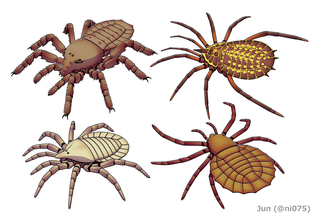
The order Trigonotarbida is a group of extinct arachnids whose fossil record extends from the late Silurian to the early Permian. These animals are known from several localities in Europe and North America, as well as a single record from Argentina. Trigonotarbids can be envisaged as spider-like arachnids, but without silk-producing spinnerets. They ranged in size from a few millimetres to a few centimetres in body length and had segmented abdomens (opisthosoma), with the dorsal exoskeleton (tergites) across the backs of the animals' abdomens, which were characteristically divided into three or five separate plates. Probably living as predators on other arthropods, some later trigonotarbid species were quite heavily armoured and protected themselves with spines and tubercles. About seventy species are currently known, with most fossils originating from the Carboniferous coal measures.
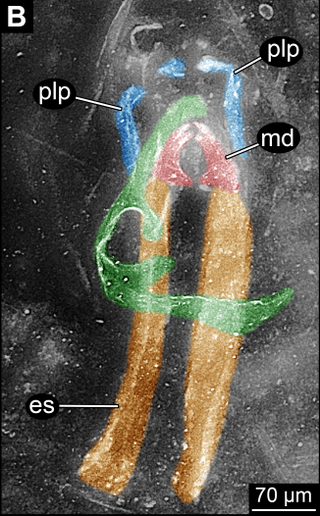
Rhyniognatha is an extinct genus of arthropod of disputed placement. It has been considered in some analyses as the oldest insect known, as well as possibly being a flying insect. Rhyniognatha is known from a partial head with preserved mouthparts from the Early Devonian aged Rhynie chert around 400 million years ago, when Earth’s first terrestrial ecosystems were being formed. The type, and only species is R. hirsti, which was named and described in 1928. Other analyses have interpreted the specimen as a myriapod.

The Nematophyta or nematophytes are a paraphyletic group of land organisms, probably including some plants as well as algae known only from the fossil record, from the Silurian period until the early Devonian Rhynie chert. The type genus Nematothallus, which typifies the group, was first described by Lang in 1937, who envisioned it being a thallose plant with tubular features and sporophytes, covered by a cuticle which preserved impressions of the underlying cells. He had found abundant disaggregated remains of all three features, none of which were connected to another, leaving his reconstruction of the phytodebris as parts of a single organism highly conjectural. No reproductive or vegetative structures common to the land plants are known, and certain members of the nematophyte plexus seem to belong to the fungi.
Rhyniella is a genus of fossil springtails (Collembola) from the Rhynie chert, which formed during the Pragian stage of the Early Devonian. One species has been described, Rhyniella praecursor. For some time it was believed to be the only hexapod from the Early Devonian

Peytoia infercambriensis is a species of hurdiid radiodont in the genus Peytoia.

Chasmataspidids, sometime referred to as chasmataspids, are a group of extinct chelicerate arthropods that form the order Chasmataspidida. Chasmataspidids are probably related to horseshoe crabs (Xiphosura) and/or sea scorpions (Eurypterida), with more recent studies suggest that they form a clade (Dekatriata) with Eurypterida and Arachnida. Chasmataspidids are known sporadically in the fossil record through to the mid-Devonian, with possible evidence suggesting that they were also present during the late Cambrian. Chasmataspidids are most easily recognised by having an opisthosoma divided into a wide forepart (preabdomen) and a narrow hind part (postabdomen) each comprising 4 and 9 segments respectively. There is some debate about whether they form a natural group.
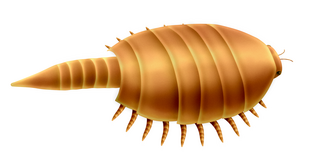
Euthycarcinoidea are an enigmatic group of extinct possibly amphibious arthropods that ranged from Cambrian to Triassic times. Fossils are known from Europe, North America, Argentina, Australia and Antarctica.

Arthropods are invertebrates in the phylum Arthropoda. They possess an exoskeleton with a cuticle made of chitin, often mineralised with calcium carbonate, a body with differentiated (metameric) segments, and paired jointed appendages. In order to keep growing, they must go through stages of moulting, a process by which they shed their exoskeleton to reveal a new one. They are an extremely diverse group, with up to 10 million species.

Megacheira is an extinct class of predatory arthropods defined by their possession of spined "great appendages". Their taxonomic position is controversial, with studies either considering them stem-group euarthropods, or stem-group chelicerates. The homology of the great appendages to the cephalic appendages of other arthropods is also controversial. Uncontested members of the group were present in marine environments worldwide from the lower to middle Cambrian.

Ventarura is a genus of extinct vascular plants of the Early Devonian. Fossils were found in the Windyfield chert, Rhynie, Scotland. Some features, such as bivalved sporangia borne laterally and the anatomy of the xylem, relate this genus to the zosterophylls. Other features are unclear due to poor preservation.

Lepidocaris rhyniensis is an extinct species of crustacean. It is the only species known from the order Lipostraca, and is the only abundant animal in the Pragian-aged Rhynie chert deposits. It resembles modern Anostraca, to which it is probably closely related, although its relationships to other orders remain unclear. The body is 3 mm (0.12 in) long, with 23 body segments and 19 pairs of appendages, but no carapace. It occurred chiefly among charophytes, probably in alkaline temporary pools.
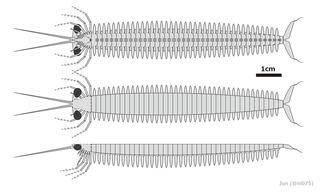
Wingertshellicus is an extinct genus of arthropod that has been found in Hunsrück Slate, that is located in the Rhenish Massif in Germany, and lived about 405 million years ago, during the Lower Emsian.

The subphylum Hexapoda or hexapods comprises the largest clade of arthropods and includes most of the extant arthropod species. It includes the crown group class Insecta, as well as the much smaller class Entognatha, which includes three orders of wingless arthropods that were once considered insects: Collembola (springtails), Protura (coneheads) and Diplura. The insects and springtails are very abundant and are some of the most important pollinators, basal consumers, scavengers/detritivores and micropredators in terrestrial environments.
The Panther Mountain Formation is a geologic formation in New York. It preserves fossils dating back to the Devonian period. It is located in the counties of Albany, Madison, Oneida, Otsego, and Schoharie. It is well known for its fossil arthropods preserved as flattened cuticles, including Attercopus and Dracochela.

Cornovichthys is an extinct genus of jawless fish in the super class Anaspidomorphi. It is known from the Middle Devonian of Scotland.

Necrogammarus salweyi is the binomial name applied to an arthropod fossil discovered in Herefordshire, England. The fossil represents a fragmentary section of the underside and an appendage of a pterygotid eurypterid, a group of large and predatory aquatic arthropods that lived from the late Silurian to the late Devonian. The Necrogammarus fossil is Late Silurian in age and its generic name means "dead lobster", deriving from Ancient Greek νεκρός and Latin gammarus ("lobster").

Bundenbachiellus is an extinct genus of arthropod described from the Lower Devonian Hunsrück Slate of Germany. This genus is known from only one species, B. giganteus. Alongside its possible relative Enalikter from Silurian, it is possible that genus is late-living example of Megacheira, "great-appendage arthropod".
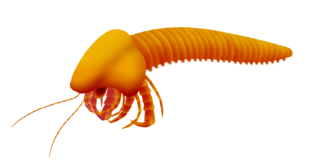
Acheronauta is a genus of extinct vermiform arthropod that lived in the early Silurian Waukesha biota fossil site in southeast Wisconsin. This arthropod was first discovered alongside the biota in 1985, but was not fully described until October 2022. This creature was recognized and described as a possible early mandibulate. This description is very important as much of the fauna of the biota remain undescribed, and its discovery has allowed for paleontologists to get a better grasp of the diversity of the arthropod fauna at the site. Multiple phylogenetic analyses were performed, and it seems that this arthropod forms a previously undiscovered clade with the Devonian stem-arthropod Captopodus, and the somewhat enigmatic group Thylacocephala.

















